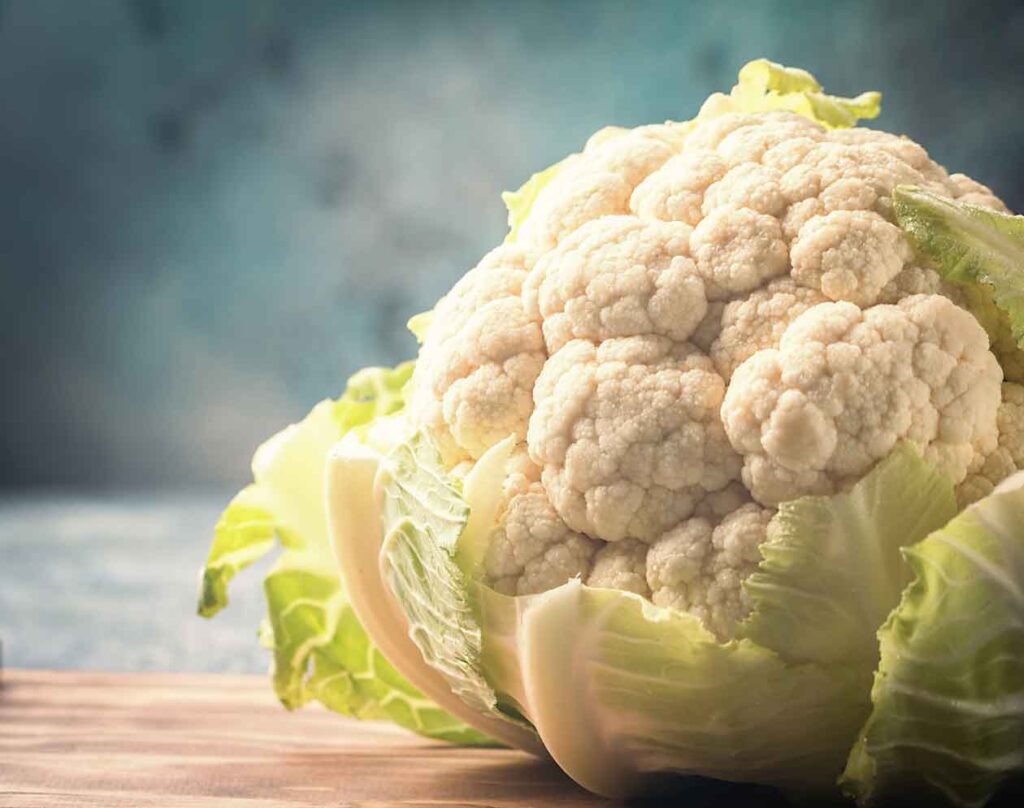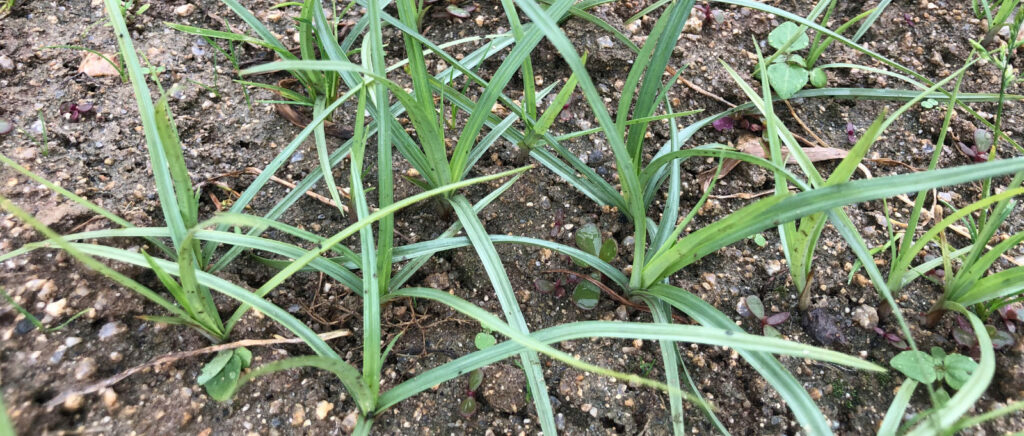Growing cauliflower is an increasingly popular agricultural practice on commercial farms and in smaller settings, from greenhouses and home and urban gardens to terraces, balconies, and pots.
Its diverse varieties, its nutritional value, and its growing demand in all types of markets mean that today we are adding to our agricultural roadmap a study on how to grow cauliflower, turning it into a wonderful, sustainable project with top-quality results that will benefit us today and tomorrow.
Once again, welcome to our Novamulch agricultural space.
Historical background and ancestral origins of cauliflower.
A family of Brassicaceae, such as broccoli, cabbage, kale, and Brussels sprouts. Brassica oleracea var. botrytis, or cauliflower as we know it today, appeared as a wild species more than 2,000 years ago in the Mediterranean lands of the East and Asia Minor, considered the birthplace of numerous agricultural species that evolved from their wild nature. These regions have served as a cultural and agricultural bridge between Europe and Asia, facilitating the exchange of plants and cultivation techniques.
Wild cabbages are the ancestors of cauliflower, resistant to temperate and saline climates, and for this reason, the ancient inhabitants of Syria, Lebanon, Palestine, Cyprus and Turkey began to domesticate them, selecting those varieties that produced larger flowers and better compacted fruits, and thus, gradually generated the cauliflower we know today.
Historical reference and morphological description of Brassica oleracea var. capitata, cauliflower, and its ancestors.
This link provides excellent information on these two key points: the evolution and specific characteristics of these vegetables.
https://es.wikipedia.org/wiki/Brassica_oleracea_var._capitata
And now let’s watch this very clear video on how to grow cauliflower.
Currently, cauliflower cultivation is one of the most important crops for global agriculture. Furthermore, it is a completely versatile vegetable, highly profitable, and highly valued in fresh vegetable markets. The latest culinary trends indicate that cauliflower is an essential ingredient, especially in healthy and vegetarian diets, as well as in the frozen and processed food industry.
For example, we have innovative cauliflower formats such as “cauliflower rice,” gluten-free pizza crusts, and frozen preparations, which places it within an expansive and broad market.
A short video about a delicious cauliflower rice recipe.
Cauliflower pizza dough? Let’s not miss this recipe!
As we can see, the rise of cauliflower in local and international markets is due to its low calorie content, its richness in vitamin C, fiber, antioxidants, and sulfur compounds that contribute to disease prevention.
Today, China and India account for the majority of global production, accounting for over 70% of the total. However, countries such as Spain, Italy, the United States, and Mexico stand out for the added value of their cauliflower production, which focuses on quality, exports, and varietal innovation.
How to grow cauliflower in different environments?
Traditionally, cauliflower is associated with growing large, open fields; however, we can successfully grow it in smaller spaces and following the appropriate agronomic requirements, as we’ll see in our Novamulch agricultural section.
Important information about growing Brassicaceae:
Preparing the land for growing cauliflower.
Let’s now explore the essential steps for properly preparing and nourishing the soil to achieve the quality needed to grow cauliflower in any environment.
First, let’s examine the conditions and nature of the soil available to us to begin our agricultural project. We need loamy or clayey soil with good aeration and drainage capacity.
If we have an open expanse, an open field, it is very likely to have elements that will prevent proper nutrient absorption, as well as compaction and weeds, so we will follow these steps:
- We will do a deep tillage of 25 to 30 cm to remove compaction and allow adequate aeration.
- We remove all plastic waste or any other material that remains, solid blocks of earth, stones, metal remains, remains from previous crops, and weeds.
- The ideal depth for growing cauliflower is between 30 and 40 cm, as this plant’s root system is extensive.
- We will level the area we have chosen to avoid waterlogging and leaching.
- It’s a good idea to measure the pH at this point to make the necessary amendments and organize the substrate measurements we’re going to apply. The proper pH range is between 6.0 and 7.0.
- We will locate the water intakes and analyze our irrigation capacity.
Soil nutrition for growing cauliflower.
We may face a dilemma at this crucial point in our agricultural roadmap. We are faced with two options: grow cauliflower using conventional methods, or explore paths toward ecological and sustainable agricultural techniques.
Yes. In our Novamulch agricultural space, we always choose to follow ecological and sustainable procedures, as we are completely respectful of our ecosystem:
Since Novamulch paper mulch naturally biodegrades throughout the entire planting cycle, we add 100% organic matter to the soil microbiota, to all the living microorganisms present: bacteria, fungi, actinobacteria, microscopic algae, protozoa and archaea, which are protective agents against pathogens and improve the level of substrate structure.
Let’s study the nutrients required for cauliflower cultivation, which is very sensitive to soil imbalances and demanding in nutrients:
Nitrogen (N): Necessary for proper leaf development. We find it in well-composted manure, as well as worm castings, legume compost, and fermented slurries such as nettle and comfrey, which also provide micronutrients. Excessive doses of organic nitrogen can delay the formation of the edible part of our cauliflower.
Phosphorus (P): Promotes initial rooting and plant resistance. It is recommended to use soft natural phosphate, a naturally occurring mineral permitted in organic systems. We can also add calcareous seaweed meal, rich in calcium and trace elements and improving soil structure; composted guano (from bats or seabirds), an excellent source of organic phosphorus and nitrogen; and bone or wood ash, which provides calcium, phosphorus, and potassium, always in moderate doses.
Let’s make a short list of what we call Vegetable Bones:
- Ash from hardwood, olive, holm oak, oak and fruit trees: rich in calcium, potassium and phosphorus.
- Ash from nutshells, almonds, walnuts and pistachios: highly mineralized and rich in calcium and potassium.
- Rice husk ash: It is an excellent source of silica and calcium.
- Ash from corn cobs and corn husks: provide phosphorus and potassium.
- Ash from olive or plum pits, the “pit” or inner woody seed: they contain high levels of calcium and phosphorus after the combustion process.
It’s important to note that when we talk about vegetable bone meal in organic farming, we’re referring to the ashes resulting from the combustion of olive, almond, plum, and other pits, which are very rich in minerals such as calcium, potassium, phosphorus, and magnesium. Let’s continue with our nutrients.
Potassium (K): Allows compaction and the acquisition of the white or creamy color of the “pella,” or edible part of the plant. It is found in wood ash, in the naturally occurring potassium sulfate permitted in organic products, in beet vinasse, and in seaweed extracts.
Calcium (Ca): prevents apical necrosis and is found in calcareous seaweed flour, natural calcium carbonate, and composted eggshells.
Essential micronutrients:
Boron (B): Its deficiency causes hollow or deformed pellets. We can correct this by using natural borax or seaweed extracts approved for organic production.
Molybdenum (Mo): essential for nitrogen assimilation and present in mature compost, natural mineral flours and liquid biofertilizers.
Suitable climatic requirements for growing cauliflower.
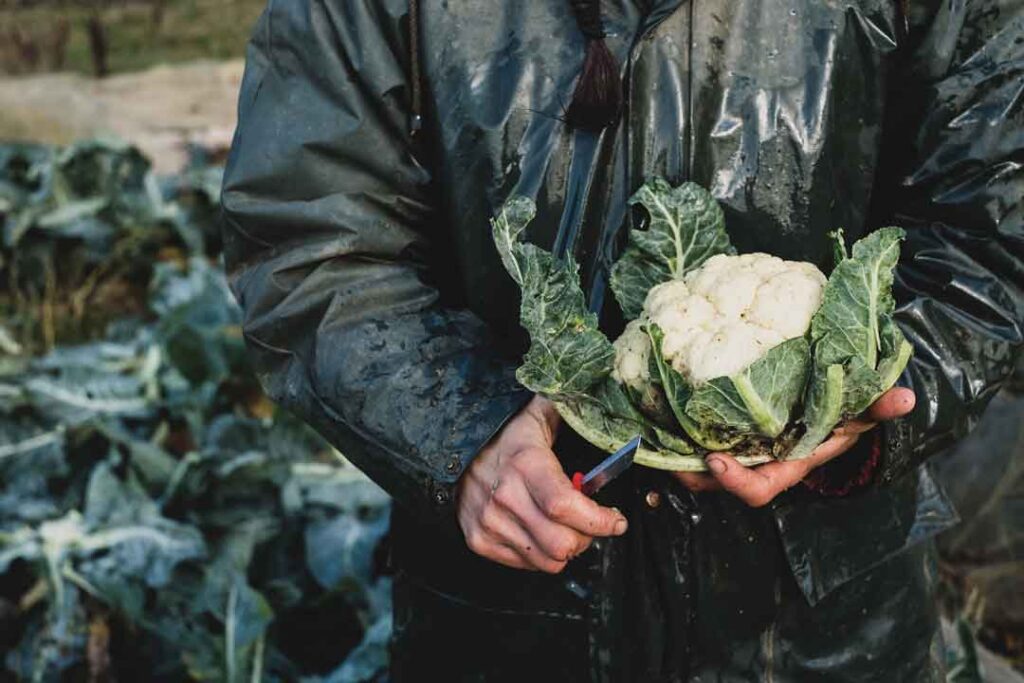
This vegetable is sensitive to extreme temperatures; therefore, it grows with excellent results in cool climates. Suitable temperatures range between 15° and 20°C. Accordingly, temperatures above 25°C reduce the size and quality of the heads. Temperatures below 10°C, and for prolonged periods, induce premature heading (early flower formation) or budding, which prevents the head from developing properly.
Do we know what buttoning is?
Budding is a physiological problem that occurs before the leaf system and nutrient reserves have sufficiently developed, and the plant will form a very small, loose, or poor-quality head.
The main causes of this anomaly are:
- Heat stress: When temperatures are too low (below 10°C for several days) during the initial stages of planting.
- Water or nutritional stress: which results in poor irrigation and a lack of nutrients, especially nitrogen.
- Premature transplants: when seedlings are transferred to the final soil before they have acquired their solid and robust structure.
- Poorly adapted varieties: due to growing long-cycle varieties in unsuitable climates or seasons.
How do we avoid button-tucking?
- It’s very important to observe the initial growth phase, when the seedlings develop between 4 and 6 good-sized true leaves. This will be the ideal time to transplant.
- We must choose varieties suitable for each growing season.
- Temperature plays a vital role in seedbeds and at the beginning of plant development, as it must be rigorously maintained in balance and within appropriate levels.
- Nutrient doses and regular drip irrigation must be guaranteed.
Novamulch biodegradable paper mulch as an advanced technique for growing cauliflower.
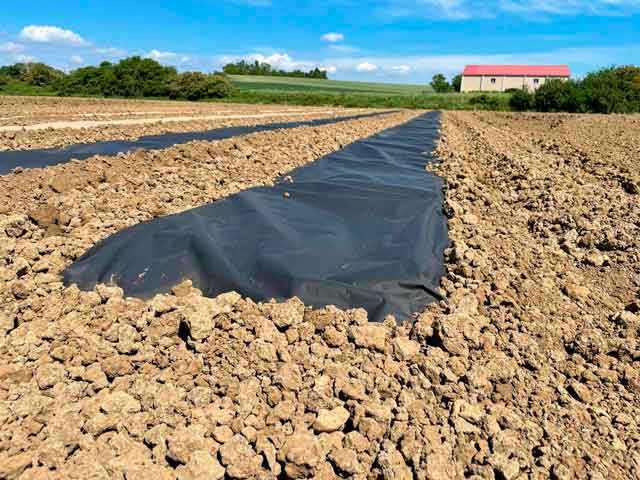
When we decide to explore how to grow cauliflower as part of our agricultural roadmap, we’re presented with many options, as we’ve discussed previously. We can choose a conventional planting method or an organic and sustainable one.
If we choose to be consistent with our environmental responsibility, let’s pause to delve deeper into the benefits and advantages that Novamulch biodegradable paper mulch brings to our project and the ecosystem.
On any cultivable environment, this material acts as a protective agent from the moment we spread it over a large area or smaller spaces.
Once we’ve prepared the soil and added the necessary substrates for our cauliflower, we apply Novamulch biodegradable paper mulch to preserve the vital foundation that will allow us to support all agronomic development, from transplanting seedlings or planting seeds to harvest time.
When direct sowing cauliflower seeds, Novamulch biodegradable paper mulch can be used, provided practical adjustments are made to allow for proper germination and vegetative growth of each plant.
When laying out the material, we must adjust and secure it at the edges, using stones, staples, or pegs to prevent it from being lifted by the wind. The paper should fit snugly against the ground, without creases.
In both cases, whether direct sowing seeds or transplanting seedlings, we open holes or cuts in the shape of a cross, large enough but not too large, at the points where we will sow. Once this is done and our seeds or seedlings are in place, we lightly cover each hole with a thin layer of substrate, and thus begins the germination or growth phase, during which we must take special care.
Remember that, unfortunately, we must remove weak or defective seedlings to give the more robust ones a chance for more vigorous development.
Let’s now look at the specific functions that Novamulch biodegradable paper mulch provides for growing cauliflower in any environment. Let’s analyze:
- This agricultural technique inhibits the emergence and proliferation of weeds such as sedge.
- It maintains a balanced soil temperature, especially in the deeper layers, thereby adequately supporting the structure of underground biodiversity, which will be integrated into natural biodegradation at the end of the crop, turning into organic matter.
- It generates a stable microclimate because, in addition to maintaining habitat control against eventual thermal variables, it controls soil humidity, avoiding the possibility of waterlogging or water ingress, and consequently preventing compaction or leaching.
- If we use drip irrigation, which is the most recommended, the biodegradable paper mulch prevents direct contact of the stems, leaves, and fruits with the soil, thus avoiding deterioration and eventual loss of our crop.
- It favors the standard parameters of cauliflower cultivation, so that the structure and quality of the plants will be of better quality and health.
- Its fully biodegradable components contribute to improving soil structure and ensure that the result of decomposition is simply a further addition to the soil’s microbiota, providing organic matter and nutrients for future crops. This means there will be no plastic or other polluting waste for our future agricultural projects.
You can purchase Novamulch biodegradable paper mulch below:
-
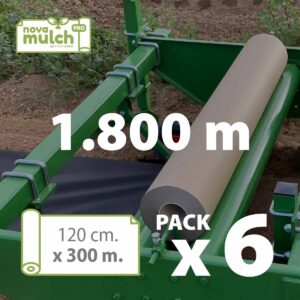 PACK of 6 rolls of Novamulch Professional paper 120 cm. x 300 m. (1.800 m)565,28 € IVA incluido
PACK of 6 rolls of Novamulch Professional paper 120 cm. x 300 m. (1.800 m)565,28 € IVA incluido -
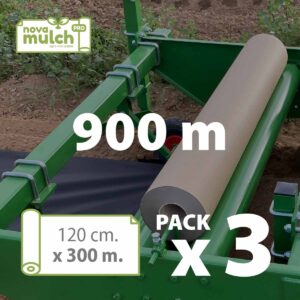 PACK of 3 rolls of Novamulch Professional paper 120 cm. x 300 m. (900 m)282,22 € IVA incluido
PACK of 3 rolls of Novamulch Professional paper 120 cm. x 300 m. (900 m)282,22 € IVA incluido -
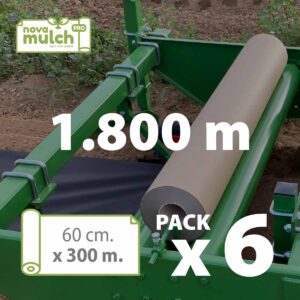 PACK of 6 rolls of Novamulch Professional paper 60 cm. x 300 m. (1.800 m)282,22 € IVA incluido
PACK of 6 rolls of Novamulch Professional paper 60 cm. x 300 m. (1.800 m)282,22 € IVA incluido -
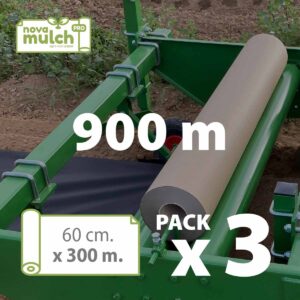 PACK of 3 rolls of Novamulch Professional paper 60 cm. x 300 m. (900 m)141,30 € IVA incluido
PACK of 3 rolls of Novamulch Professional paper 60 cm. x 300 m. (900 m)141,30 € IVA incluido -
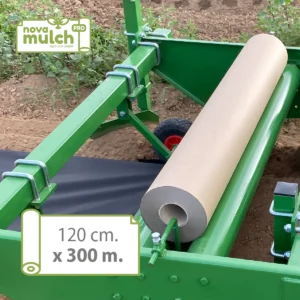 Novamulch Professional Paper 120 cm. x 300 m.94,21 € IVA incluido
Novamulch Professional Paper 120 cm. x 300 m.94,21 € IVA incluido -
 Novamulch Professional Paper 60 cm. x 300 m.47,10 € IVA incluido
Novamulch Professional Paper 60 cm. x 300 m.47,10 € IVA incluido -
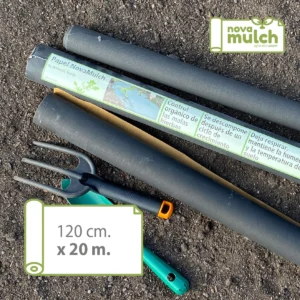 Novamulch paper 120 cm. x 20 m.41,63 € IVA incluido
Novamulch paper 120 cm. x 20 m.41,63 € IVA incluido -
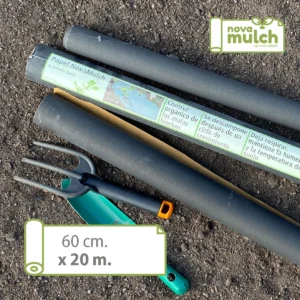 Novamulch paper 60 cm. x 20 m.21,89 € IVA incluido
Novamulch paper 60 cm. x 20 m.21,89 € IVA incluido -
 Novamulch paper 60 cm. x 10m.14,85 € IVA incluido
Novamulch paper 60 cm. x 10m.14,85 € IVA incluido -
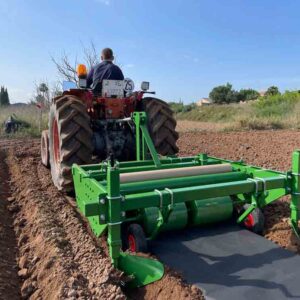 Novamulch agricultural mulching machine
Novamulch agricultural mulching machine
How to grow cauliflower outdoors?
This is the most common method we find in cauliflower crops. It’s a vegetable that requires special care, as it’s very demanding when it comes to climatic and thermal fluctuations, in addition to needing adequate amounts of water and nutrients. This leads us to commit to providing continuous care throughout the entire planting process.
We’ve already studied the preparation and nutrition of the growing area, and now we’ll see which varieties are best for successfully implementing our agricultural plan.
How to grow cauliflower outdoors for organic purposes?
Which cauliflower varieties are suitable for growing outdoors?
It’s advisable to choose varieties based on the planting season and the area’s climatic conditions. We can select F1 hybrids if we’re planning commercial crops, due to their uniformity and fruit hardiness.
If we plan diversified production, let’s combine early, mid- and late varieties to stagger our harvest times.
Let’s choose varieties resistant to diseases like cabbage leaf spot, especially in soils with a history of these diseases. Remember that proper rotation, solarization, and organic spraying, as well as careful soil preparation and nutrition, are very important.
Early varieties (short cycle: 70–90 days).
Very suitable for sowing in spring or in areas with a temperate climate, if we are looking for short-term production:
Snowball Y Improved.
- Open-pollinated variety (not hybrid).
- Early cycle, around 70–85 days from transplant.
- White, rounded, compact and medium-sized ball.
- Moderate leaf cover, and in sunny climates may require protection (blanching by folding leaves).
- Well suited for cultivation in family gardens, small-scale and sustainable agriculture, both in open fields, on terraces, and in urban and domestic gardens.
Early Snowball A.
- Similar to the previous one but produces a more homogeneous harvest.
- Recommended for farmers looking for quick market entry.
- It allows for rapid rotations and early harvests, but is less resistant to both high and low temperatures.
- Medium-cycle variety (90–120 days), and is one of the most popular for growing in open fields as it offers a better balance between quality, head size and yield.
Fremont.
White, firm head, and excellent leaf coverage.
Widely used in intensive commercial production.
Clapton F1.
Hybrid with high resistance to cabbage herniation (Plasmodiophora brassicae).
Highly recommended for soils with a history of this disease.
Skywalker F1.
- Versatile hybrid, recommended for autumn harvests.
- Very uniform pellets and good preservation after harvest.
- This variety is more stable and adaptable to different environments, but requires good pre-planting planning to prevent bolting.
Late cauliflower varieties (120–150 days).
They are intended for winter or early spring harvests in temperate regions:
Apex.
Excellent quality of pellet, large and white, and very resistant to low temperatures.
David F1.
It produces large, compact heads and is recommended for autumn-winter crops.
Winter Domes.
- Traditional winter variety as it tolerates low temperatures.
- It produces a larger size, which gives it better commercial quality.
- It requires stable cool climates and more time in the field.
Special color varieties (green, purple and orange).
Although less common in traditional productions, they are increasingly in demand in gourmet and organic markets:
Graffiti (purple).
Intense purple colored peel, rich in antioxidants.
Cheddar F1 (orange).
High beta-carotene content and visual appeal.
Green of Macerata (green).
- It is sensitive to warm temperatures.
- Classic Italian variety, widely accepted for fresh consumption.
- It has high added value in differentiated markets, even though it achieves lower demand in mass production.
How to grow cauliflower in home and urban gardens?
Let’s take note on our agricultural roadmap of the essential requirements we must consider before growing cauliflower in our home and urban gardens.
Pre-selection of space and location:
We need direct sunlight of at least 5 to 6 hours a day, and we place our containers in a well-ventilated area but not exposed to strong winds.
Each cauliflower requires between 60 and 70 cm of separation, so these beds should be sized accordingly.
Let’s prepare the soil and substrates as explained above. A substrate rich in compost and worm castings, along with other slow-release organic nutrients, is especially beneficial for this environment. However, let’s avoid excessive doses of nitrogen to prevent delaying the formation of the pellet.
To grow cauliflower in these environments, drip irrigation is required to keep the soil and substrate moist but not excessively so. It is also important to create seedbeds for transplanting when the seedlings have grown to 4 to 6 true leaves.
Let’s review the treatment we are going to apply in case of pests and diseases.
The most common pests in cauliflower crops are caterpillars, aphids, and snails. In home and urban gardens, we can implement manual methods (removing insects by hand from young plants), install protective netting against cabbage moths, and apply potassium soap, neem extract, or nettle slurry, all of which are very effective in combating these pests and diseases.
We can improve the biodiversity of our cauliflower crop by planting marigolds and nasturtiums to attract natural predators.
And 80 to 120 days after transplanting or sowing seeds, depending on the variety, we can harvest our cauliflower, especially when we notice that the head turns white and its structure is compact; before it begins to open, it will be the right time to harvest.
Which cauliflower varieties are suitable for growing in home and urban gardens?
Choosing cauliflower varieties to grow in this type of environment requires us to consider key variables for successful harvests, as not all varieties are adaptable to these spaces.
We need to study and select their adaptability to grow in smaller spaces, with shorter growth cycles, good resistance to pests and diseases, and compact, easily manipulated pellets. Let’s study.
Early or short-cycle varieties (70–90 days).
They are the most recommended for growing in urban and domestic gardens, since they generate several harvests per year and we can have the growing space available in less time:
Snowball Y Improved.
We’ve already analyzed this variety, but let’s narrow it down: One of the most classic and widespread varieties in home gardens. It produces medium-sized, compact, white heads. It adapts well to both large pots and raised beds.
Early Snowball A.
Short-cycle, it produces a consistent harvest. Very practical for those seeking quick results in urban areas.
Igloo.
- Very short cycle variety (70–75 days).
- Perfect for growing tables and small school or community gardens.
- Because its cycle is short, this variety is easy to manage and, if grown in good quality substrates, will produce excellent and very profitable fruits.
Medium-cycle varieties (90–110 days).
Suitable for urban gardens with larger spaces, and for those looking to obtain large, uniform balls:
Clapton F1.
A hybrid resistant to cabbage leaf blight (Plasmodiophora brassicae) and very useful in soils with a history of this disease. It produces firm, high-quality heads.
Skywalker F1.
A versatile variety, suitable for both fall and spring planting. It produces very uniform heads with good leaf cover, which protects them from the sun.
Candid Charm.
- Recognized in home horticulture for its natural leaf covering that whitens the head without the need for tying it, and recommended for growing in gardens with intense sunlight.
- It is more resistant to variable thermal and climatic conditions.
Special color varieties.
These are increasingly popular in urban and home gardens for their visual appeal and added nutritional value:
Graffiti (purple).
It produces purple flowers rich in anthocyanins. It is a very attractive plant for school and community gardens.
Cheddar F1 (orange).
Rich in beta-carotene. It provides unique culinary and nutritional value.
Green of Macerata (green).
A traditional Italian variety. It adapts well to small gardens and is highly valued in gastronomy. It brings diversity, appeal, and added value to small gardens.
Practical recommendations for home and urban gardens.
- Select early or mid-season varieties that guarantee rapid harvests.
- Prefer resistant hybrids in spaces where cruciferous crops are planted repeatedly.
- Incorporate colorful varieties to diversify production and enrich the diet.
- Grow in containers with a capacity of 20 to 30 liters, or in deep beds that allow for good root development.
- Plan staggered plantings to provide fresh cauliflower for several months.
- As we’ll see later, we should consider integrating or associating beneficial plants with our cauliflower crop, which act as natural repellents for pests common to this species and its varieties.
The most suitable varieties for domestic and urban gardens are short-cycle varieties such as Snowball Y Improved or Igloo, medium-cycle varieties such as Clapton F1 and Skywalker F1 for their resistance and uniformity, and coloured varieties such as Graffiti or Cheddar F1 for their added value.
With these options, in these smaller environments we will have the opportunity to obtain compact, nutritious, and visually appealing pellets.
How to grow cauliflower in a greenhouse?
A greenhouse is always a very convenient environment, especially if our climatic and thermal conditions are fluctuating or unstable, and the soil structure we rely on for our crops is not in adequate condition to begin our cauliflower growing plan.
Remember that this vegetable especially requires soil with good aeration and drainage capacity, free of plastic waste or compacted or solid waste that can generate contamination. The greenhouse offers us the possibility of conveniently and carefully addressing all these variables, as it creates a protected microclimate and habitat for nutrition.
Preparing the soil and nutrient requirements is no different than what we recommend for other environments. However, to enrich the substrate, we can add coconut fiber and perlite to allow for better aeration and loosening of the soil. Don’t forget to measure the pH and check if it’s within the appropriate range: 6.0 to 7.0.
Let’s examine the ideal thermal conditions: for vegetative development, between 15°C and 20°C. For head formation, between 12°C and 18°C. We’ll avoid temperatures above 25°C and below 10°C. The former generate small, open heads, while the latter induce premature bolting or budding.
Humidity levels should be maintained between 60% and 80%. Biodegradable paper mulch plays a fundamental role here, regulating and balancing both soil temperature and proper humidity. A level above 80% will make the entire area susceptible to the development of diseases such as botrytis or downy mildew, which we’ll discuss later.
Greenhouses typically have skylights and side windows that help regulate ventilation, temperature, and humidity; however, we must take these values into account in our microclimate.
During hot periods with intense sunlight, it is advisable to install shading nets to maintain thermal and solar balance within our protected environment.
Suitable cauliflower varieties for greenhouses.
We need to choose varieties that can adapt to a controlled habitat such as a greenhouse, with good tolerance to relative humidity and moderate temperatures. To obtain compact, uniform, high-quality commercial crops, it is key to select modern, hardy hybrids, as well as early varieties that make better use of the protected space. Let’s study.
Early varieties (short cycle: 70–90 days).
They are suitable for small greenhouses and urban or indoor gardens if our goal is to achieve short-term rotations. We have tested the Snowball, Improved, and Igloo varieties, which are also suitable for our greenhouse.
Medium-cycle hybrid varieties (90–120 days).
Specially designed for professional greenhouses, they are uniform, disease-resistant, and highly productive. Within this group, we have already evaluated the varieties that define these parameters: Clapton F1, Skywalker F1, and Candid Charm.
Special color varieties.
These cauliflower varieties are highly prized for commercial greenhouse cultivation in gourmet and organic markets. We again include Graffiti (purple), Cheddar F1 (orange), and Verde di Macerata (green).
Practical recommendations for growing cauliflower in a greenhouse.
- Select resistant F1 hybrids if our goal is directed towards commercial production.
- Choose early varieties for urban and indoor gardens to make the most of the space.
- Growing colorful varieties in greenhouses geared toward gourmet consumers or short-term marketing channels.
- Plan our crops in stages to ensure continuous and consistent harvests.
How to grow cauliflower on terraces, balconies, and in pots?
In these even smaller environments, we can also achieve high-quality cauliflower plantings. We need planters, containers, or pots 30 to 40 cm deep to allow for healthy and robust root development. Let’s review the necessary nutrients, using a mix with good aeration and drainage capacity.
Recommended composition:
- 40% topsoil or mature compost.
- 30% coconut fiber or blond peat to improve water retention.
- 20% worm humus as a source of organic nutrients.
- 10% perlite or coarse sand for drainage.
- Optimal pH: between 6.0 and 7.0. More acidic soils promote cabbage root rot.
Background fertilization and maintenance:
- Before planting, mix in well-rotted compost or mature manure.
- During the cycle, reinforce with fractional fertilization, with nettle slurry, compost tea, or seaweed extracts, which provide nitrogen, potassium, and micronutrients such as boron and molybdenum.
- Avoid excess nitrogen, as it delays pellet formation.
Climate requirements for growing cauliflower on terraces, balconies, and in pots.
The appropriate temperature during the vegetative growth phase ranges between 15° and 20°C. During head formation, we need to achieve a temperature between 12° and 18°C. Temperatures above 25°C produce small, open heads, while temperatures below 10°C can cause budding (poorly formed heads).
As with all small spaces, we require 5 to 6 hours of direct sunlight daily, and if our terraces and balconies receive intense sunlight, we should install shade netting. Furthermore, these environments are susceptible to faster evaporation, so regular watering is important to maintain soil moisture.
If our areas experience strong winds, we will use windbreaks or natural barriers with more resistant plants.
How to grow cauliflower in pots?
Suitable cauliflower varieties for terraces, balconies and pots.
While growing cauliflower in these environments is a fairly common trend, not all varieties are suitable for successful growth in these formats. To obtain compact, high-quality heads in these types of containers, we must choose early, hardy, moderate-sized varieties that grow well in 20- to 30-liter containers.
Let’s review the most suitable varieties below.
Early varieties (short cycle: 70–90 days).
They are the most recommended for pots because they require less growing time and produce quicker harvests. We’ve already analyzed the Snowball Y Improved varieties, Early Snowball A (short cycle, very uniform, and also very suitable for community gardens on terraces), and the Igloo variety. All allow for several annual rotations and are easily manageable in these small spaces.
Medium-cycle varieties (90–110 days).
Suitable for large pots or raised beds on terraces with more space:
Clapton F1 and Candid Charm; we’ve reviewed both for cauliflower cultivation in home and urban gardens.
The special color varieties Graffiti (purple), Cheddar F1 (orange), and Verde di Macerata (green) are also highly recommended for growing in these environments.
Practical recommendations for growing cauliflower on terraces, balconies, and in pots.
- Choose early varieties (Snowball, Igloo) if our spaces are limited and we are looking for quick harvests.
- Let’s select resistant hybrids (Clapton F1, Candid Charm) for large containers and we can obtain greater quality and uniformity.
- We recommend incorporating colorful varieties into educational, community, and family gardens, especially to integrate children and young people into our agricultural projects and achieve a harmonious connection with our green roadmap.
Beneficial associations for growing cauliflower.
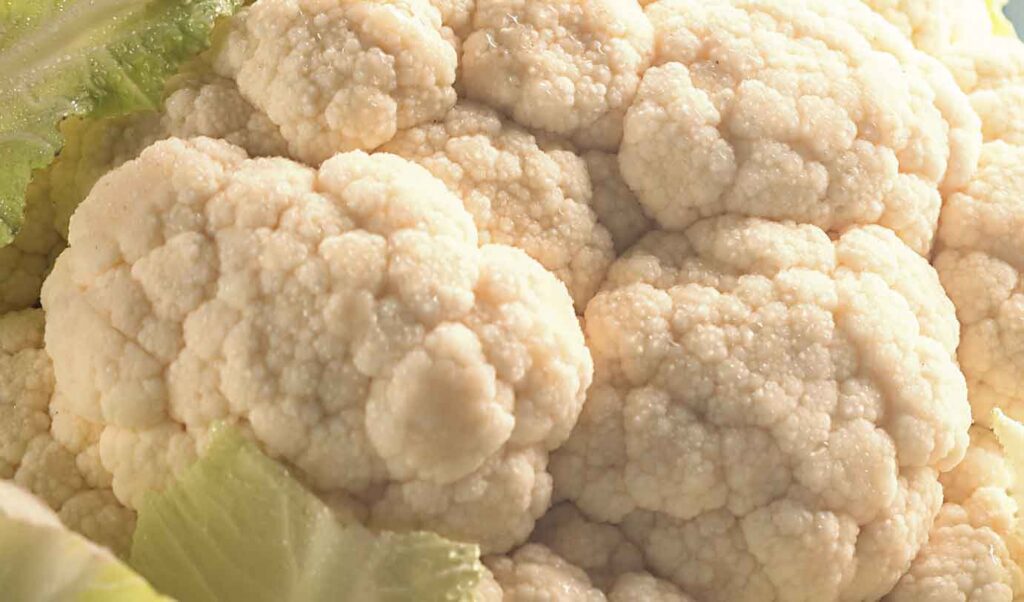
We suggest you review articles we’ve published in our agricultural space, Novamulch, and we present them below, hoping to make it much easier for you to learn how to combine compatible and beneficial plants to achieve a better ecological balance in your cauliflower crop and improve your production.
Plantar Aromáticas. Un proyecto enriquecedor con ventajas rentables todo el año.
Cómo cultivar Apio. Una planta peculiar y versátil.
Cuándo y cómo plantar cebollas : Guía detallada para un cultivo exitoso.
Harvest times for growing cauliflower.
When we study how to grow cauliflower, we learn that harvest times will depend on the varieties we’ve selected in our agricultural roadmap and the time of year we start planting. Let’s analyze.
A complete cycle can range from 75 to 150 days from the time of transplant or seed sowing. If we start in spring, the cycles will be shorter, approximately 80 to 100 days. And if we start in fall/winter, the cycles will be much longer, between 120 and 150 days, as lower temperatures slow the cauliflower’s development.
Proper storage to keep cauliflower in impeccable condition.
Once we’ve harvested our cauliflower, it begins a process of rapid quality loss, which is why we must implement highly effective storage methods to keep it fresh and at its best.
Let’s study the critical factors that we will take into account to achieve effective results.
Conventional storage.
- Storage temperature: between 0° and 2°C with relative humidity between 90% and 95%. The shelf life is approximately 2 to 3 weeks.
- Temperatures above 5°C accelerate respiration and shorten the shelf life of our fruits. Levels below 0°C deteriorate quality by causing frostbite.
- It is advisable to keep some outer leaves to protect the head from possible impacts and dehydration.
Controlled atmosphere storage.
- In this type of conservation we will regulate the proportion of gases (oxygen, carbon dioxide and nitrogen) within a controlled chamber.
- The appropriate conditions in these cases are 1% to 2% oxygen and 2% to 5% carbon dioxide, at a temperature of 0° to 2°C; this helps maintain the color and firmness of the pellets and reduces the possibility of mold growth. This extends shelf life to 4 to 6 weeks.
Modified atmosphere storage.
- We package cauliflower in breathable or compostable plastic films that modify the internal atmosphere of the container. This will protect our produce from dehydration and reduce yellowing of the stem.
- This way, we can extend the shelf life by up to 3 to 4 weeks if we use good-quality packaging and implement a cold chain with the correct levels.
Home storage in refrigerator.
- We wrap our cauliflower in biodegradable paper or breathable bags to maintain humidity without excessive condensation. By storing it in the vegetable drawer of the refrigerator, we avoid placing it near climacteric fruits such as apples or bananas, which produce ethylene and accelerate their deterioration.
- We will achieve approximately 7 to 10 days in good conditions.
Recommended summary:
- Continuous cold chain: from the field to the final consumer.
- High relative humidity: prevents dehydration and wilting.
- Physical protection: preserve outer leaves and use appropriate packaging.
- Careful handling: avoid impacts and excessive pressure during transport and stacking.
Common pests and diseases to consider before growing cauliflower.
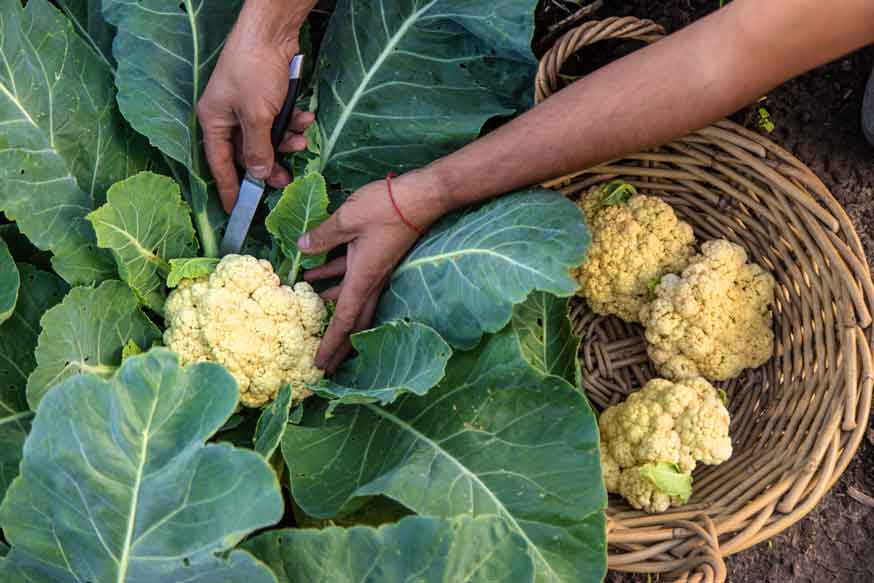
Let’s start with the common pests of cauliflower crops, which reduce and deteriorate the quality and quantity of these vegetables.
Cabbage caterpillar (Pieris brassicae and Pieris rapae).
Description:
White butterflies that lay yellow eggs on the underside of leaves. The caterpillars are green and voracious.
Damage:
Leaf perforations, reduction of photosynthetic area, and, in severe attacks, damage to the leaf surface.
Control:
Manual harvesting in small gardens.
Use of Bacillus thuringiensis (Bt), approved for organic farming.
Promote natural enemies such as parasitoid wasps.
Cabbage moth (Plutella xylostella).
Description:
Small nocturnal moths, between 6 and 8 mm, with highly mobile green larvae.
Damage:
Leaf galleries, skeletonization, and growth distortions.
Control:
Crop rotation to prevent pupae from accumulating in the soil.
Introduction of natural predators.
Biological applications of Bt or plant extracts (neem).
Cabbage fly (Delia radicum).
Description:
Gray fly similar to the housefly; the white larvae attack roots.
Damage:
Wilting of young plants, stunted growth; in extreme cases, death of seedlings.
Control:
Use insect-proof netting in seedbeds and during the initial planting stages.
Crop rotation to break the cycle.
Incorporate yellow traps for adults.
Aphids (Brevicoryne brassicae, cabbage aphid).
Description:
Small, grayish insects that gather in colonies.
Damage:
Sap suction, general weakening of the plant, transmission of viruses, and leaf deformation.
Control:
Introduce natural predators such as ladybugs and lacewings.
Spray with potassium soap or nettle extract in organic farming.
Avoid excess nitrogen, which promotes proliferation.
Trips (Thrips tabaci).
Description:
Elongated, tiny insects measuring between 1 and 2 mm; difficult to detect with the naked eye.
Damage:
Silver spots on leaves, necrosis, and reduced photosynthetic capacity.
Control:
Blue sticky traps.
Maintain adequate humidity, as thrips prefer dry environments.
Apply organic plant extracts (neem oil).
Snails and slugs.
Description:
Mollusks that appear in high humidity conditions.
Damage:
They devour young leaves and can perforate the head.
Control:
Manual harvesting in small gardens.
Beer traps or moist cardboard shelters.
Physical barriers with wood ash or crushed husks.
Integrated Pest Management (IPM) strategy for cauliflower.
Prevention:
Crop rotation, removal of plant debris, and use of resistant varieties.
Constant monitoring:
Check the undersides of leaves and the base of plants.
Biological control:
Promote beneficial insects (ladybugs, lacewings, parasitoids).
Bioinsecticides:
Use of Bacillus thuringiensis, neem extracts, or potassium soaps authorized for organic production.
Cultural measures:
Maintain nutrient balance, especially nitrogen, to prevent explosive aphid populations.
What are the common diseases we should be aware of before growing cauliflower?
These vegetables are highly susceptible to various diseases of fungal, bacterial, and physiological origin; these pathologies can compromise the quality of the head and significantly reduce yield if we don’t take prior measures and establish preventive and curative management strategies. Let’s study.
Cabbage hernia (Plasmodiophora brassicae).
Causative agent:
Soil parasitic protist.
Symptoms:
Thickening and deformation (galls) on the roots.
Yellowing and wilting of leaves during hot weather.
Stunted plants and poor root development.
Soil-borne parasitic protist.
Favorable conditions:
Acidic soils with a pH below 6.0 and excessive moisture.
Control:
Maintain soil pH between 6.5 and 7.2 by liming.
Crop rotation with non-cruciferous crops.
Use resistant varieties.
Soil solarization in small gardens.
Downy mildew (Peronospora parasitica).
Causative agent:
Pomycete (mildew type fungus).
Symptoms:
Yellowish spots on the upper surface of the leaves.
Appearance of a whitish-gray mold on the underside.
In extreme cases, defoliation and weakening of the plant.
Pumiceto (mildew-like fungus).
Favorable conditions:
High relative humidity, above 80%, and temperatures between 12° and 18°C.
Control:
Avoid excessive planting density to promote ventilation.
Avoid prolonged overhead irrigation.
Use tolerant varieties.
Preventive application of antifungal plant extracts (horsetail, garlic).
Botrytis or gray mold (Botrytis cinerea).
Causative agent:
Polyphagous fungus very common in humid temperate climates.
Symptoms:
Soft, watery rot on outer leaves and stems.
A spongy, gray mold appears on affected tissues.
Rapid growth in high humidity conditions.
Favorable conditions:
High humidity and cool temperatures between 15° and 20°C.
Control:
Promote crop aeration.
Avoid excessive or flooded watering.
Remove infected plant debris.
Apply Trichoderma spp.-based biofungicides.
Alternariosis (Alternaria brassicae, A. brassicicola).
Causative agent:
Necrotrophic fungus.
Symptoms:
Dark, concentric necrotic spots on older leaves.
Premature defoliation and plant weakening.
In severe attacks, stems and leaves are affected.
Favorable conditions:
Temperatures between 20° and 27°C, and high humidity levels.
Control:
Crop rotation and residue removal.
Use of certified pathogen-free seeds.
Preventive biological treatments with neem extracts or biofungicides.
Bacterial black spot (Xanthomonas campestris pv. campestris).
Causative agent:
Bacterial phytopathogenic bacteria (Xanthomonas campestris pv. campestris).
Symptoms:
V-shaped lesions on leaf margins.
Browning of veins and wilting.
Decreased quality of the stem.
Favorable conditions:
Warm temperatures and high humidity.
Control:
Use certified, bacterium-free seeds.
Crop rotation.
Avoid sprinkler irrigation, which promotes spread.
Application of biofertilizers based on antagonistic microorganisms.
Apical necrosis (calcium deficiency physiopathology).
Cause:
Calcium deficiency in the soil or difficulty absorbing calcium due to irregular irrigation.
Symptoms:
Browning and necrosis at the edges of the root ball.
Soft, loose texture.
Calcium deficiency in the soil or difficulty absorbing calcium due to irregular irrigation.
Favorable conditions:
Soils poor in calcium, water stress, or excess salts.
Control:
Provide calcium through calcareous kelp meal, calcium carbonate, or wood ash in organic systems.
Maintain constant humidity with uniform irrigation.
Integrated disease management strategy for cauliflower.
Prevention:
Use certified seeds, resistant varieties, long rotations, and pH control.
Field hygiene:
Remove crop debris and cruciferous weeds.
Irrigation management:
Avoid waterlogging and excessive humidity.
Biological control:
Application of Trichoderma spp., Bacillus subtilis, and antifungal plant extracts.
Constant monitoring:
Early detection of symptoms for rapid action.
General conclusion and final reflections.
We’ve seen that learning how to grow cauliflower allows us to contribute to creating more and more responsible and beneficial agricultural models for everyone.
By including in our roadmap the study and cultivation of these essential vegetables, such as this one, due to its versatility in our kitchens, its high nutritional value, and its excellent profitability, cauliflower becomes a great opportunity to commit to resilient, sustainable agriculture in total harmony with nature, today and tomorrow.

